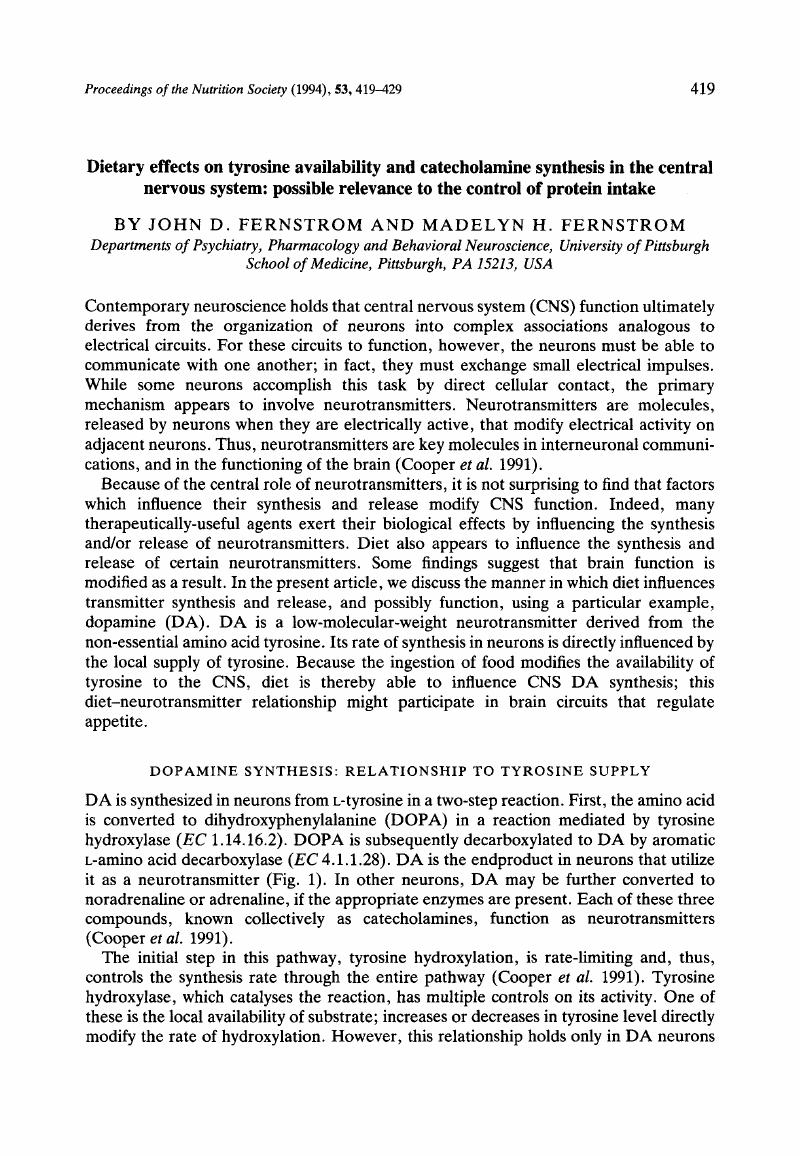Crossref Citations
This article has been cited by the following publications. This list is generated based on data provided by Crossref.
Rogers, Peter J.
and
Lloyd, Helen M.
1994.
Nutrition and mental performance.
Proceedings of the Nutrition Society,
Vol. 53,
Issue. 2,
p.
443.
Vander Tuig, Jerry G.
and
Beneke, William M.
1996.
A Low-Protein Diet Blocks Development of Hyperphagia and Obesity in Rats with Hypothalamic Knife Cuts.
The Journal of Nutrition,
Vol. 126,
Issue. 6,
p.
1713.
TYRRELL, HENRY A.
1998.
Tyrosine: Food Supplement or Therapeutic Agent?.
Journal of Nutritional & Environmental Medicine,
Vol. 8,
Issue. 4,
p.
349.
Fernstrom, John D
2000.
Can nutrient supplements modify brain function?.
The American Journal of Clinical Nutrition,
Vol. 71,
Issue. 6,
p.
1669S.
Dixon, Marjorie
2001.
Clinical Paediatric Dietetics.
p.
233.
Bongiovanni, Rodolfo
Yamamoto, Bryan K.
and
Jaskiw, George E.
2001.
Improved method for the measurement of large neutral amino acids in biological matrices.
Journal of Chromatography B: Biomedical Sciences and Applications,
Vol. 754,
Issue. 2,
p.
369.
de Pedro, N.
Delgado, M. J.
and
Alonso‐Bedate, M.
2001.
Fasting and hypothalamic catecholamines in goldfish.
Journal of Fish Biology,
Vol. 58,
Issue. 5,
p.
1404.
Leigh Gibson, E.
and
Green, Michael W.
2002.
Nutritional influences on cognitive function: mechanisms of susceptibility.
Nutrition Research Reviews,
Vol. 15,
Issue. 01,
p.
169.
Leigh Gibson, Edward
2006.
Emotional influences on food choice: Sensory, physiological and psychological pathways.
Physiology & Behavior,
Vol. 89,
Issue. 1,
p.
53.
Bosch, G.
Beerda, B.
Hendriks, W. H.
van der Poel, A. F. B.
and
Verstegen, M. W. A.
2007.
Impact of nutrition on canine behaviour: current status and possible mechanisms.
Nutrition Research Reviews,
Vol. 20,
Issue. 2,
p.
180.
MacDonald, Anita
Dixon, Marjorie
and
White, Fiona
2007.
Clinical Paediatric Dietetics.
p.
310.
Femstrom, John D.
and
Femstrom, Madelyn H.
2009.
Monoamines and Protein Intake: Are Control Mechanisms Designed to Monitor a Threshold Intake or a Set Point?.
Nutrition Reviews,
Vol. 59,
Issue. 8,
p.
S60.
Verheesen, R.H.
and
Schweitzer, C.M.
2009.
Micronutrients and amino acids, main regulators of physiological processes.
Medical Hypotheses,
Vol. 73,
Issue. 4,
p.
498.
Best, Janet A
Nijhout, H Frederik
and
Reed, Michael C
2009.
Homeostatic mechanisms in dopamine synthesis and release: a mathematical model.
Theoretical Biology and Medical Modelling,
Vol. 6,
Issue. 1,
Fernstrom, John D.
2009.
Diet, Neurochemicals, and Mental Energy.
Nutrition Reviews,
Vol. 59,
Issue. 1,
p.
S22.
Reed, Michael C.
Lieb, Anna
and
Nijhout, H. Frederik
2010.
The biological significance of substrate inhibition: A mechanism with diverse functions.
BioEssays,
Vol. 32,
Issue. 5,
p.
422.
Best, Janet
Nijhout, H Frederik
and
Reed, Michael
2010.
Serotonin synthesis, release and reuptake in terminals: a mathematical model.
Theoretical Biology and Medical Modelling,
Vol. 7,
Issue. 1,
Bungo, Takashi
Yanagita, Kouichi
and
Shiraishi, Jun-ichi
2010.
Feed Intake after Infusion of Noradrenalin, Dopamine or its Precursor into the Lateral Ventricles in Neonatal Chicks.
Journal of Animal and Veterinary Advances,
Vol. 9,
Issue. 4,
p.
760.
Frank, Sabine
Veit, Ralf
Sauer, Helene
Enck, Paul
Friederich, Hans-Christoph
Unholzer, Theresa
Bauer, Ute-Maria
Linder, Katarzyna
Heni, Martin
Fritsche, Andreas
and
Preissl, Hubert
2016.
Dopamine Depletion Reduces Food-Related Reward Activity Independent of BMI.
Neuropsychopharmacology,
Vol. 41,
Issue. 6,
p.
1551.
Brodnik, Zachary D.
Double, Manda
España, Rodrigo A.
and
Jaskiw, George E.
2017.
L-Tyrosine availability affects basal and stimulated catecholamine indices in prefrontal cortex and striatum of the rat.
Neuropharmacology,
Vol. 123,
Issue. ,
p.
159.



